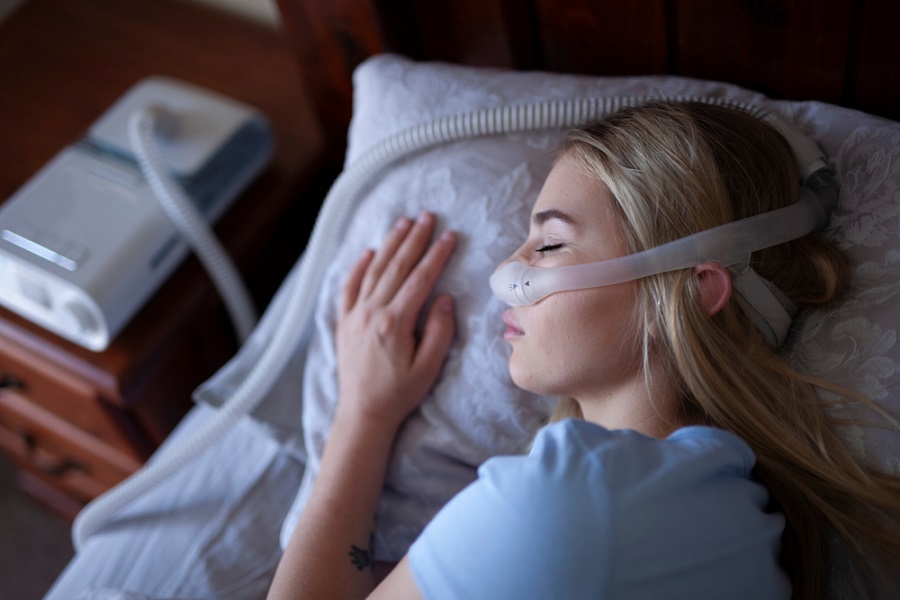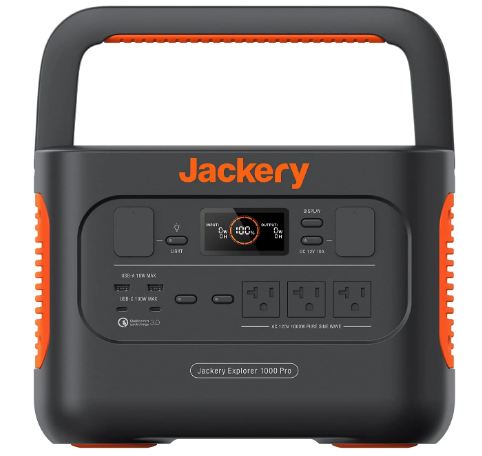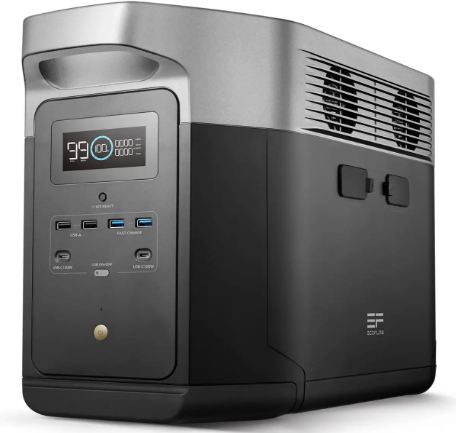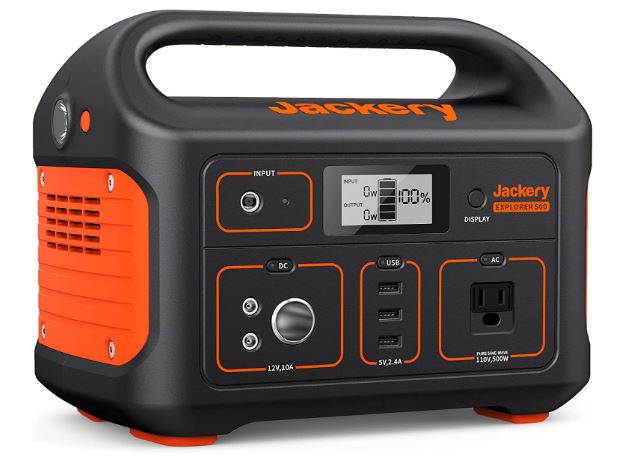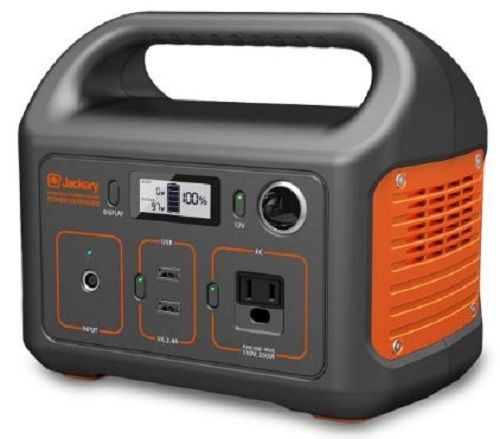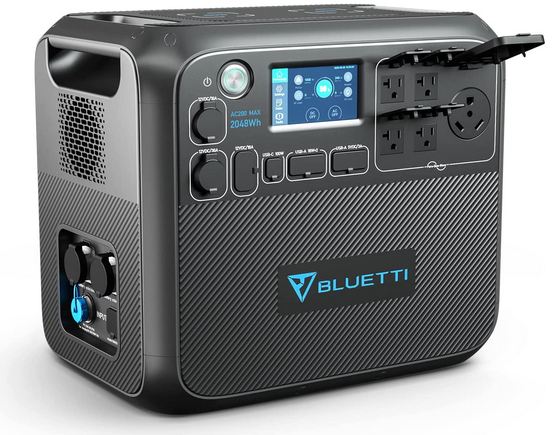Are you looking for a safe, reliable solar generator for CPAP backup?
You have come to the right place.
Solar generators, depending on the unit you opt for, are a reliable way to provide power to your CPAP machine in the event of a power outage.
They are portable and easy to use. There is no need for an external electrical source or gas supply. No fuel or dangerous emissions to worry about.
This also makes them a perfect option for those who want an alternative energy source that is environmentally friendly and safe.
According to Bluetti, on average, 22 million Americans experience sleep apnea (OSA). One way to deal with sleep apnea is CPAP.
A reliable solar generator must be able to run a CPAP machine for at least one night per day of charging. If you plan to use it for other backup purposes, then you will need to factor in the additional Wh of energy those devices will consume.
Most portable solar generators can meet this demand, so it can be overwhelming to pick a suitable unit from so many options.
This guide should help you narrow your options to the one unit that best meets your budget and CPAP backup requirements.
So let’s get to it.
In this buying guide, we recommend, review, and compare the 6 best solar generators for CPAP backup.
After comparing our top 6 picks and reviewing each briefly, we’ll walk you through the key features and gotchas to look for when buying a solar generator including installation, maintenance, and other tips.
Finally, we answer common questions asked about solar generators for CPAP.
Hopefully, this buying guide will help you find the best solar generator for your specific needs and situation.
If you have any questions, leave us a comment below.
How Much Power Does A CPAP Use?
The solar generator you choose will depend a lot on how much power your CPAP uses. You want a solar generator that can power the CPAP machine the entire night (6-8 hours).
To be safe, we recommend getting a solar generator that can power your CPAP for at least 2-3 nights (16-24 hours). This ensures that you can still use your CPAP if you are unable to recharge the solar generator everyday.
CPAP machines generally use between 30 and 60 watts. The exact consumption depends on its pressure setting and whether you use it with a humidifier.
Some CPAP machines can use as little as 15-20W when the humidifier is turned off and there are newer CPAP machines that use as much as 100W.
Check if your CPAP has the power consumption indicated on the unit or somewhere in the user guide. You can also check the exact consumption using a Kill A Watt monitor like this one. Measure consumption with the humidifier turned on and off.
If your CPAP machine uses 60W of power with all features turned on, it’ll consume 240Wh of power over 8 hours.
So you need a minimum 300Wh capacity solar generator to keep your CPAP on the entire night. The extra capacity accounts for the solar generator’s 80-85% depth of discharge as well as power losses.
If you want enough backup power for three nights, a 1kWh solar generator is ideal.
As for power output, make sure the solar generator can deliver the max power your CPAP draws. For a 60W CPAP machine, you need a minimum 60W solar generator. But it’s a good idea to get a slightly larger solar generator just to be safe (for a 60W CPAP, a 100W solar generator is perfect).
Best Solar Generators for CPAP
Disclaimer: All links below go to Amazon.com
- 1Our Top Pick: Jackery Explorer 1000 Pro
- 2Best For CPAP & Appliances: EcoFlow Delta Max
- 3Best For Camping: Jackery Explorer 500
- 4Best Compact: Bluetti EB3A
- 5Best Budget: Jackery Explorer 240
- 6Best For Emergencies: Bluetti AC200MAX
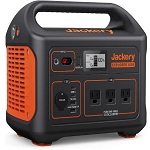
Jackery 1000 Pro
Our top pick
1002Wh capacity
800W output
14hr runtime (60W CPAP)
25.4lbs
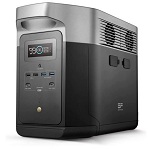
EcoFlow Delta Max
Best for CPAP & appliances
2016Wh capacity.
2400W output
28hr runtime (60W CPAP)
48lbs
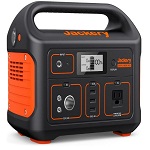
Jackery 500
Best for camping
518Wh capacity
500W output
7.3hr runtime (60W CPAP)
13.3lbs
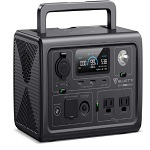
Bluetti EB3A
Best compact
268Wh capacity
600W output
5.7hr runtime (40W CPAP)
10.1lbs
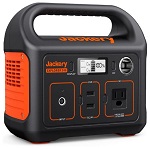
Jackery 240
Best budget
240Wh capacity.
200W output
5hr runtime (40W CPAP)
6.8lbs
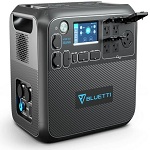
Bluetti AC200MAX
Best for emergencies
2048Wh capacity
2200W output
29hr runtime (60W CPAP)
62lbs
1. Our Top Pick: Jackery Explorer 1000 Pro
The Jackery Explorer 1000 Pro can power a 60W CPAP machine for 14 hours (or about two nights), it’s light enough to take with you when you travel, and it can also power other appliances and electronics.
Pros
Cons
Our Review
The Jackery Explorer 1000 Pro is an upgrade of the still-popular Jackery Explorer 1000. The new model comes with improved output options and faster charging.
With a capacity of 1002Wh, the Explorer 1000 Pro has no trouble powering a 60W CPAP machine through the night. It can actually power a CPAP for two nights, or about 14 hours total.
Power output is 800W, so you can run other appliances at the same time as the CPAP without tripping the inverter.
The Jackery Explorer 1000 Pro weighs 25.4lbs, making it easy to travel with whether you are going camping, on a business trip, a road trip or overlanding.
AC & DC Output Options
You can plug your CPAP machine into one of the three AC outlets. If your CPAP uses a 12V power cable (or if you are using a 12V adapter), the Jackery 1000 Pro also has a 12V car outlet.
You can also charge your phone and other devices via the four USB ports: two 18W USB-A ports and two 100W USB-C ports.
Fast Recharging
If you are camping with the Explorer 1000 Pro, you don't have to worry about having no power at night. The Jackery power station recharges fast with solar.
It accepts up to 800W of solar power, which charges it in just 1.8 hours. Even if you used a smaller 300W solar array, you can still charge the Jackery 1000 Pro in less than a day.
If you have access to a generator or mains power, you can charge the 1000 Pro with 800W AC in 1.8 hours.
There’s also a car charging option, though it’s only ideal for topping up the power station when you are on the go.
Issues & Limitations
While the Jackery 1000 Pro is light, it’s not ultra-light. It’s fine if you plan to carry it in your vehicle.
But if you want a CPAP solar generator you can carry around by hand, the Jackery 1000 Pro is a bit hefty. Consider getting the Jackery 500 or 240 instead.
2. Best For CPAP & Appliances: EcoFlow Delta Max
If you want a solar generator that can power your CPAP as well as other appliances, get the EcoFlow Delta Max.
It has a 2kWh battery and a 2.4kW inverter that can support multiple appliances and electronics.
Pros
Cons
Our Review
The EcoFlow Delta Max is a bit oversized if you just want to power a CPAP. But it’s perfect for running multiple appliances and electronics at home, when truck camping or in your RV.
The 2400W power output (3400W with X-Boost) can handle your CPAP’s consumption plus several other appliances at the same time.
The 2016Wh capacity is also plenty enough to handle all your power needs. If you just plug in your CPAP, the Delta Max can power it for 28 hours or about three and a half nights.
If you want to power other appliances at the same time, make sure you can still get a full night of power out of it. For instance you can power a 150W refrigerator and your CPAP simultaneously and you’ll still get eight hours out of the Delta Max battery.
If you want a longer runtime or if you want to power multiple appliances without draining the battery too quickly, the Delta Max is expandable up to 6kWh.
The extra batteries are handy if you are living off-grid or you want to be ready for a power blackout.
15 Outlets
The Delta Max has six AC outlets, making it easy to power several appliances at the same time. If your CPAP has a 12V power cord, you can plug it into the 12V car port.
There are also a couple of 5.5mm DC outlets for smaller 12V electronics.
You also get six USB ports including a pair of USB-A ports, a pair of fast charging USB-A ports and another pair of 100W USB-C ports.
Fast Charging
The EcoFlow Delta Max accepts up to 800W of solar power, which charges it in just 2.5 hours. You can easily recharge the Delta Max in less than a day, ensuring you have a full battery at night for your CPAP.
AC charging from an outlet or generator is even faster. AC input is 1800W, which charges the Delta MAx in just 1.8 hours.
The Delta Max also offers dual solar + AC charging.
Issues & Limitations
The Delta Max solar generator weighs 48lbs, making it less than ideal if you are looking for a highly portable solar generator.
3. Best For Camping: Jackery Explorer 500
The Jackery Explorer 500 is powerful enough to power a CPAP through the night, yet light and compact enough that you can easily take it with you when camping.
Pros
Cons
Our Review
The basketball-sized Jackery Explorer 500 power station is perfect for powering your CPAP away from home. It weighs just 13.3lbs.
With a capacity of 518Wh, the Explorer 500 can easily power a 40-60W CPAP throughout the night. If you run your humidifier or heater, it can power your CPAP for several full nights.
The Explorer 500 has a power output of 500W, more than enough to power any CPAP machine as well as most small appliances like a fan or car fridge.
AC & DC Outlets
You can choose between the AC outlet and the 12V car port to power your CPAP (Tip: the 12V output is more efficient and the battery will last longer).
There are also a couple of 6.5mm DC outlets and three USB-A ports.
Three Ways To Charge
The Jackery 500 offers three standard recharging options: solar, AC and car.
Issues & Limitations
The biggest issue with the Jackery 500 is its slow recharge speed. Jackery has been upgrading their solar generators to improve charging performance (the Explorer 2000 Pro, 1500 Pro and 1000 Pro charge a lot faster), but they are yet to upgrade the Jackery 500.
With a max solar input of just 100W, the Jackery 500 takes 7.5 hours to recharge with solar. That’s about two days of solar charging.
AC and car charging are faster at 5.5 hours.
If you want a lightweight solar generator that recharges faster, try the Bluetti EB3A, which we review next.
4. Best Compact: Bluetti EB3A
The Bluetti EB3A is another highly portable CPAP solar generator that’s great for camping, outdoors and travel.
Unlike the Jackery 500, the EB3A charges a lot faster with either solar or mains power.
Pros
Cons
Our Review
The Bluetti EB3A weighs about 10 pounds, making it one of the lightest and smallest solar generators in the market.
It’s a great choice if you need to take your CPAP with you when you travel.
The EB3A power station has a power output of 600W, so it’s more than capable of powering a CPAP machine as well as most small appliances such as a mini fridge.
It comes with a 268Wh LiFePO4 battery. That’s not much capacity, which is why we recommend the EB3A only if you have a low-power CPAP or if you often use your CPAP without the heater and humidifier.
The 268Wh battery will run a 40W CPAP for about 5.7 hours and a 60W CPAP for 3.8 hours. When you turn off the heater and humidifier, the Bluetti EB3A can last the entire night.
Nine Outlets
The Bluetti EB3A has plenty of outlets for its size. You can power your CPAP machine via the 12V car port or one of the two AC outlets.
If you have small 12V electronics, there are a couple of 5.5mm DC outlets. To recharge your phone and other devices, there’s a wireless charging pad, two USB-A ports and one USB-C 100W port.
Fast Charging
The Bluetti EB3A has less capacity compared to other CPAP solar generators, so it’s not surprising that it charges faster. But it’s also better than similar capacity power stations.
Max solar input is 200W, which recharges the EB3A in a quick 2 hours.
AC input is even higher at 350W. The Bluetti EB3A is actually the first solar generator we’ve seen with AC input higher than battery capacity. It can charge from a wall outlet in just 1.8 hours.
If that’s not fast enough for you, you can also combine solar and AC (430W max) to speed up charging.
You can also charge the EB3A from your car outlet in 3.3 hours.
Issues & Limitations
The biggest limitation of the Bluetti EB3A is its capacity. The low capacity is what makes it compact and lightweight, but it also limits how long you can power a CPAP machine.
If you only need to run your CPAP for 4-6 hours or if you run your CPAP without the humidifier, the EB3A is fine. But if you need a solar generator that’s going to power your CPAP (humidifier included) for 6-8 hours, go with the Jackery 500 or something bigger.
5. Best Budget: Jackery Explorer 240
Shopping on a budget? We recommend the Jackery Explorer 240. It has limited capacity, but it’s one of the cheapest CPAP solar generators you’ll find.
Pros
Cons
Our Review
The Jackery Explorer 240 is even smaller than the Bluetti EB3A. With a capacity of 240Wh, it’s not the best pick for high powered CPAP machines that use 60W or more of power.
We recommend it for smaller 40W units. And even then, it’ll power the CPAP for about 5 hours. But if you don't usually use the humidifier and heater, it can last the entire night.
The Explorer 240 has a power output of 200W, which is enough to power any CPAP machine as well as small appliances like a car fridge or a fan.
Four Outlets
The Jackery 240 has just one AC outlet, so you can only run one appliance at a time. There’s also a 12V car port if you prefer powering your CPAP via DC power.
You can charge your phone, camera and other devices using the two USB-A ports.
Three Ways To Recharge
The Jackery 240 accepts up to 60W of solar power. So it takes some time - about 5.5 hours - to recharge using the sun.
Car charging is quicker at 5 hours and AC charging from a wall outlet takes 3.5 hours. Overall, not bad but could be better considering this small size of the battery.
Highly Portable
The Jackery 240 weighs an easy 6.8lbs. If you want a CPAP solar generator you can easily carry around especially when traveling, the Jackery 250 is an excellent choice.
Issues & Limitations
If you want a solar generator that will keep your CPAP running the entire night, don't get the Jackery 240. It provides a 5 hour run time, and that’s with a small 40W CPAP connected.
The Jackery 500 is still highly portable, but can power a 60W CPAP for the entire night.
6. Best For Emergencies: Bluetti AC200MAX
The high capacity of the Bluetti AC200MAX ensures that you can keep your CPAP running for days in case of an emergency. You can even expand the capacity if you need a longer runtime or if you want to power other appliances.
Pros
Cons
Our Review
The Bluetti AC200MAX comes with a massive 2048Wh LiFePO4 battery. That’s enough to power a 60W CPAP machine for 29 hours or about three and a half nights (longer if you typically sleep for less than 8 hours).
The AC200MAX will easily keep your CPAP running in case of a prolonged power outage.
You can get an even longer runtime by adding more batteries. The AC200MAX is expandable to 8192Wh.
Assuming you only power your CPAP, this capacity can keep your CPAP running for 14 days. The expandable capacity is also handy if you want to backup other appliances in addition to the CPAP.
The AC200MAX has a continuous power output of 2200W, so it can easily handle most household appliances.
Versatile Outlets
As you’d expect for a solar generator of its size, the Bluetti AC200MAX has plenty of output options - 16 to be specific.
They include five AC outlets (one of them being a 30A RV port), four 12V outlets (including a 12V/30A RV output), 5V USB-A ports, 18W USB-A ports, and a 100W USB-C output. There’s also a wireless charging pad.
Fast Charging
Don’t worry that the AC200MAX will take forever to recharge because of its large capacity. It’s actually faster than many smaller solar generators.
Max solar input is 900W, which charges the AC200MAX in a quick 2.7 hours.
Charging from a wall outlet is a bit slower at 4.5 hours, but that’s still good for a 2kWh solar generator. But you can get a second adapter and charge the AC200MAX from two wall outlets at the same time in just 2.5 hours.
You can also combine AC + solar charging to reduce charging time to 2 hours.
Issues & Limitations
All that capacity and output from the Bluetti AC200MAX doesn't come cheap. If you are looking for a cheaper alternative that can still power your CPAP for a couple of days or so, try the Jackery Explorer 1000 Pro.
Features to Consider When Buying A Solar Generator for CPAP
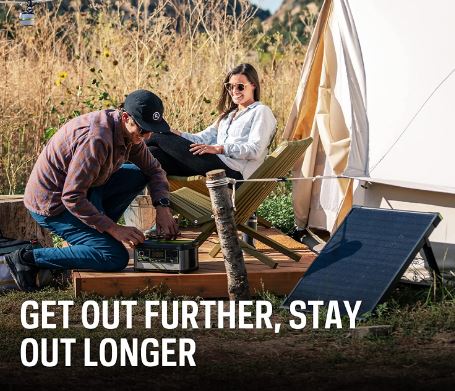
Here are the most important features and factors to consider when shopping for a CPAP solar generator.
Capacity
How long will the solar generator power a CPAP?
That’s the most important question when choosing a solar generator. The last thing you want is a solar generator that shuts off in the middle of the night.
If most of your nights are 6-8 hours long, you need a solar generator that can run the CPAP for that long.
If you have a 60W CPAP, you’ll need 240Wh of capacity (60W * 8hrs). Add a 20% margin (to account for power losses and battery depth of discharge) and get a minimum 288Wh solar generator.
If you want a solar generator that will power the CPAP for a couple nights or longer without having to recharge it, multiply the nightly consumption of your CPAP by the number of nights you want the solar generator to last. Add a 20% margin.
In our case, the CPAP uses 240Wh each night. We want a solar generator that can power it for three nights, so it has to have a capacity of at least 720Wh (240Wh * 3). Adding a 20% margin, we find we need a minimum 864Wh solar generator. The Jackery 1000 Pro is perfect for our needs.
If you want to power your CPAP plus other appliances, figure out how much power you’ll need overall and get a solar generator that’s adequate for your needs.
Power Output
Because CPAP machines use very little power, most solar generators can easily run a CPAP. CPAPs generally use between 30 and 60W, though some modern ones can use up to 100W.
So even a small 100-200W solar generator is enough to power a CPAP.
Just keep in mind that low power output typically goes hand in hand with low capacity. So even though a 150W solar generator can power a CPAP, it probably has a too-small battery that won’t keep the CPAP on the entire night.
Outlets
Some CPAP machines connect to a standard house outlet, while others are designed to plug into a 12V car output.
Make sure the solar generator you buy offers both AC and DC output options.
Tip: If your CPAP uses an AC plug, consider getting a DC adapter for it. Powering your CPAP via the 12V outlet avoids power losses via the inverter, which extends battery life.
Check that the solar generator also has USB ports for charging your phone and other devices.
Charging Speed
Get a solar generator that you can recharge quickly to ensure you have a full battery at night. Our favorite CPAP solar generators recharge with solar or AC power in less than 5 hours.
If you are getting a CPAP for camping or traveling, make sure it also offers car charging.
Portability
If you are getting a solar generator to power your CPAP when traveling, camping, in your RV and other places away from home, look for one that’s light, compact and easy to carry around.
But if you are getting a solar generator for home backup or to use in your off-grid cabin, you can get something heavier and bigger since you don't need to haul it around.
Frequently Asked Questions
What’s the difference between CPAP, APAP, and BiPAP machines?
There are three main types of sleep apnea machines: CPAP, APAP, and BiPAP. CPAP is the most common type and stands for continuous positive airway pressure. This machine pumps a constant stream of air into your airways to keep them open.
APAP, or automatic positive airway pressure, is a newer type of machine that adjusts the pressure depending on how you’re breathing. If the pressure is too high, it will lower it. And if the pressure is too low, it will raise it.
BiPAP, or bilevel positive airway pressure, delivers pressure for inhaling and exhaling. Whereas CPAP delivers only one pressure.
Depending on the solar generator you opt for, you can easily power a CPAP machine.
How many watts does a CPAP machine use?
A typical CPAP machine uses 30-60 watts.
How long can a solar generator power a CPAP machine?
Typically, a CPAP machine uses 30-60 watts and requires a solar generator of at least 500Wh if you want the CPAP machine to give you 8 hours of sleep. If you will be running other devices along with the CPAP machine, it is recommended to opt for a 1000Wh model.
Will a 200, 300, And 400 watt inverter run a CPAP machine?
Yes, most CPAP machines can be powered by 400, 300, or even 200 watt inverters.
How do I use my CPAP machine for camping?
The most important thing is to have a power source when using a CPAP machine for camping. A reliable solar generator can run a CPAP machine for at least one night per day of charging.
Final Verdict: What Is The Best Solar Generator For CPAP Backup?
In our opinion, the BLUETTI Portable Power Station AC200MAX is a great all-use solar generator with enough power to handle your CPAP for several nights or a bunch of other devices.
This is the unit for you if you’re looking for a solar generator for running a variety of appliances along with your CPAP machine.
But of course, feel free to re-read our list to find the best solar generator to help backup CPAP devices when you’re out and about.

